Want to learn how to make buttermilk at home? Then you’re in the right place! This is the best buttermilk recipe using premium grass-fed whole milk and freshly squeezed lemon juice that transforms the regular milk into a tangy delight. A simple stir and a short wait, and you have a homemade buttermilk substitute that can replace store-bought buttermilk in any recipe.

Buttermilk is an essential ingredient that lends a tangy depth to a variety of dishes, from pancakes and cakes to salad dressings and fried chicken. Making it at home not only ensures the quality of the ingredients but also adds a homemade touch to your dishes.
My recipe is distinctive because it’s easy, quick, and flexible. It’s an excellent backup for those times when you run out of buttermilk in the middle of a recipe. Plus, the lemon juice not only helps the milk to curdle but also adds a fresh, citrusy note. Try this recipe, and store-bought buttermilk will never be the same again.
Want to learn how to make buttermilk? Then keep on reading.
Table of Contents
- What is Buttermilk?
- What Makes This Recipe Special?
- What You Need to Make Buttermilk at Home
- How to Make Buttermilk (Step-by-Step)
- Tips for Making the Best Buttermilk Ever
- How to Use Buttermilk In Your Recipes
- Recipe and Substitution Variation Ideas
- Frequently Asked Questions
- How to Store Leftover Buttermilk
- Recipes that Require Buttermilk
- Recipe Card
- How to Make Buttermilk (Homemade Buttermilk Recipe + Tips)
- Comments
What is Buttermilk?
Buttermilk is a slightly sour milk product that is often used in baking, pancake recipes, and more. Traditionally, it's the liquid left behind after churning butter from cream. It’s known for its tangy flavor and ability to tenderize baked goods. The tangy flavor comes from the bacteria that ferment lactose, the sugar in milk, into lactic acid.
Now, store-bought version is a cultured dairy product, meaning it’s been fermented with bacteria. But if you find yourself without any, or need a dairy-free buttermilk substitute, you can easily make homemade buttermilk.
My recipe is incredibly simple and easy, and will give you foolproof results every single time! Try this simple recipe right now and use it in place of store-bought buttermilk in all your recipes.
What Makes This Recipe Special?
Easy to make: This recipe only requires two simple ingredients: grass-fed whole milk and freshly squeezed lemon juice. Just stir these two together and let the mixture sit for a while. No churn or special equipment is needed, making it an absolute breeze to whip up.
Versatile: This recipe can be used in any recipe that calls for buttermilk. Whether it’s for pancakes, cakes, buttermilk biscuits, or even fried chicken, this recipe has got you covered.
Delicious: The tangy flavor that this adds to baked goods is nothing short of amazing. It sets the stage for a moist, flavorful finish that store-bought versions just can’t match. Plus, the freshly squeezed lemon juice gives it an extra kick of freshness.
Your next secret ingredient: Whether you’re baking for your family or for a crowd, this buttermilk recipe is a guaranteed hit. It adds a depth of flavor to your dishes that will have everyone asking for your secret ingredient.
What You Need to Make Buttermilk at Home
All you need are some simple pantry staple ingredients to make this recipe at home. Let's look at them in more detail:
- Grass-fed Whole Milk: You’ll be needing some grass-fed whole milk to make this recipe. The whole milk will be the base, providing a creamy, rich foundation that will be transformed by the addition of an acidic ingredient.
- Freshly Squeezed Lemon Juice: We’ll also need some freshly squeezed lemon juice. The lemon juice serves a vital role in this recipe, as it will react with the whole milk, causing it to curdle slightly and create that tangy flavor that characterizes buttermilk.
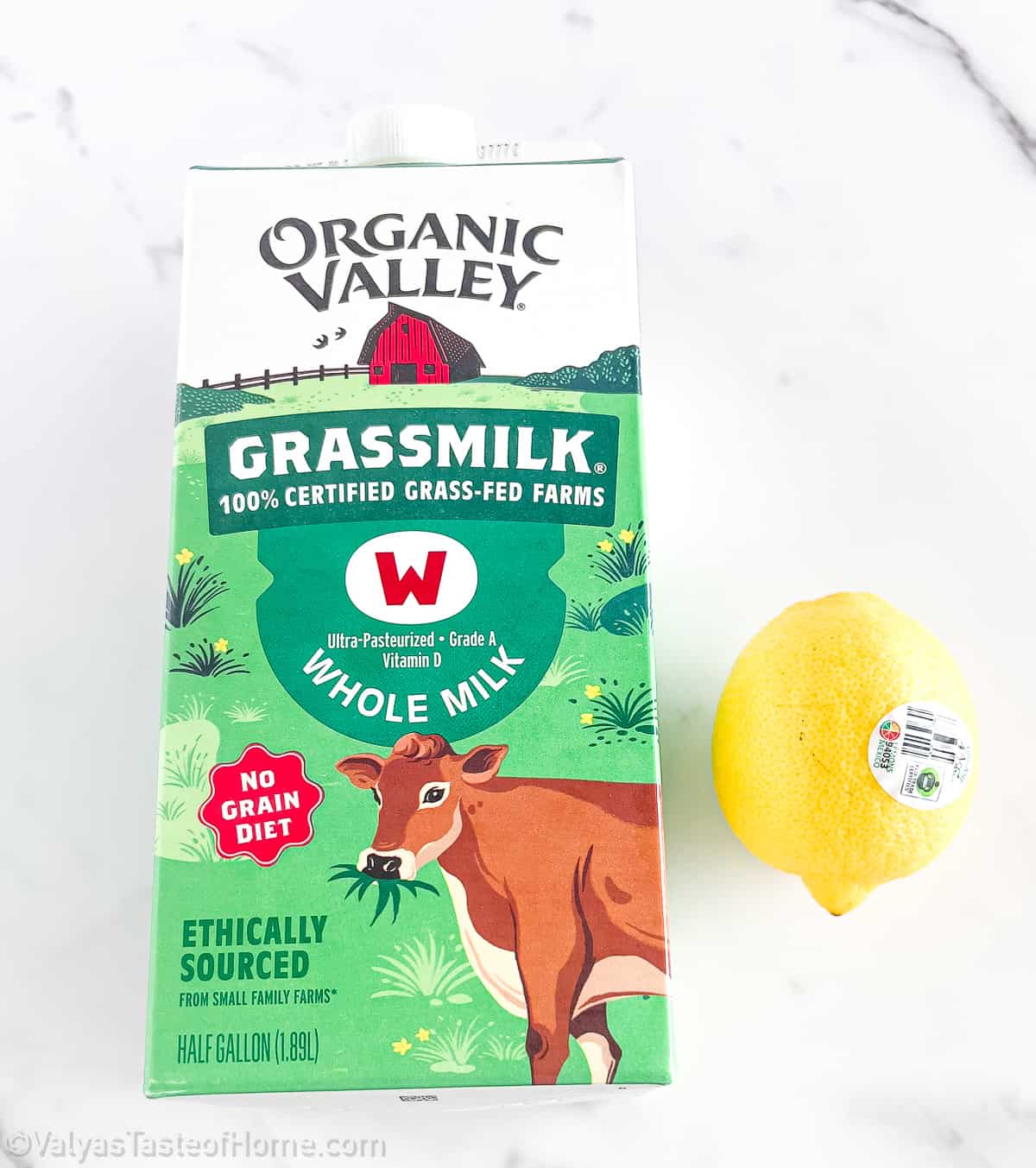
These two ingredients will work together to create a buttermilk substitute that can be used in everything from pancakes and cakes to fried chicken and salad dressing. And the best part is that it can be stored in the fridge in an airtight container for future use, saving you from relying on store-bought versions.
How to Make Buttermilk (Step-by-Step)
Making this incredible recipe is easier than you think. Here's how to make them at home step by step:
You’ll first need to measure out your whole milk and pour it into a suitable container. Any bowl or jug will work, but ideally, it should be something that allows for easy stirring. Next, take a fresh lemon and squeeze its juice directly into the milk. As a quick tip, rolling the lemon on the counter before you cut it can help to release more juice when you squeeze it.
Once you’ve added the lemon juice to the milk, use a spoon or a whisk to stir the liquid gently. This is a crucial step as the lemon juice will start to react with the milk, starting the curdling process that will give the buttermilk its tangy flavor and distinctive texture. The stirring ensures that the lemon juice is evenly distributed throughout the milk, thus making sure you get the best results.
After stirring, leave the mixture to sit on your countertop for around 10 to 15 minutes. During this time, the acid in the lemon juice will continue to react with the bacteria in the milk, further adding to the curdling process. You’ll know it's ready when it looks slightly thicker than regular milk and has small curdled milk particles floating on the surface.
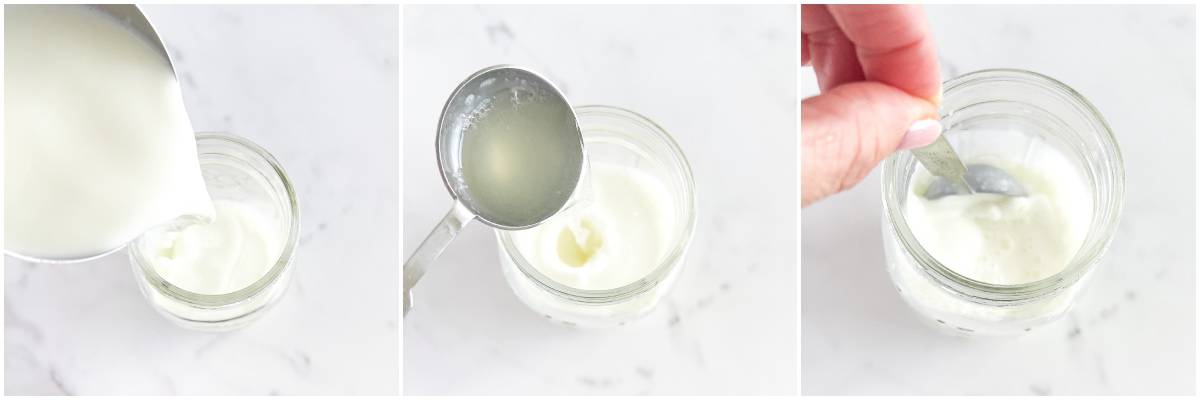
Now your homemade buttermilk is ready to be used! Whether your recipe calls for buttermilk pancakes, buttermilk biscuits, fried chicken, or even a tangy salad dressing, this buttermilk substitute will add that special tangy flavor to all your favorite dishes.
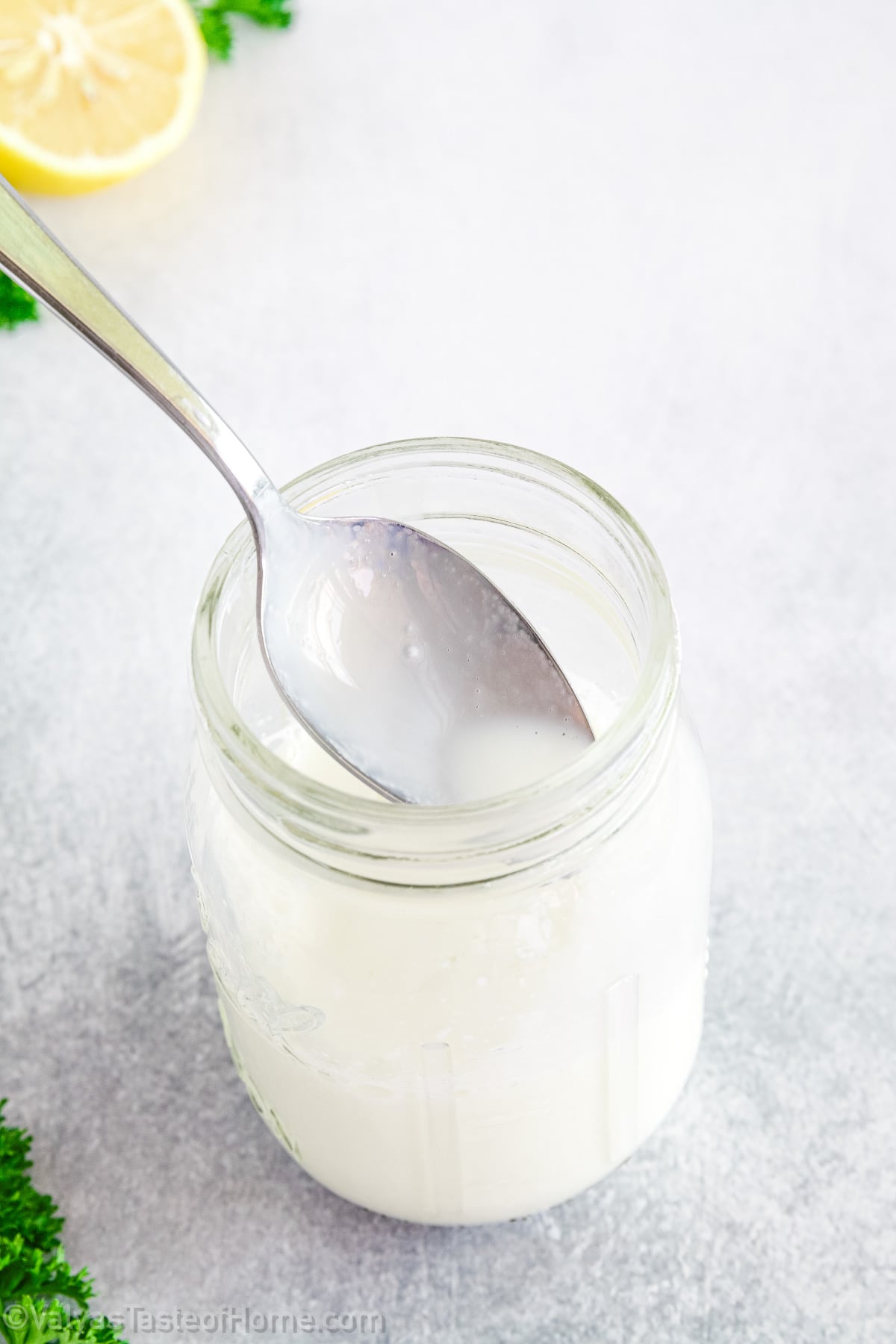
Tips for Making the Best Buttermilk Ever
Choosing the Right Milk: For this recipe, grass-fed whole milk is the best choice. It is rich in flavor and nutrients making a wonderful base. If you do not have access to it, regular milk can be used instead.
Waiting Time: After you stir the ingredients, let the mixture sit on the countertop for 10 to 15 minutes. This allows enough time for the acid in the lemon juice to react with the milk, creating the curdling effect that results in buttermilk.
Using the Buttermilk: It's now ready to be used in any recipe that calls for buttermilk. Whether you’re making pancakes, cakes, buttermilk biscuits, or fried chicken, this recipe will add a delicious tangy flavor that enhances the overall taste of the dish.
Buttermilk Substitutions: If you’re out of whole milk or prefer a dairy-free or vegan option, there are several substitutions for making homemade buttermilk. Almond milk or soy milk combined with apple cider vinegar or white vinegar can make a vegan buttermilk. You can also use coconut milk and plain yogurt or Greek yogurt as a substitute for a similar tangy flavor.
How to Use Buttermilk In Your Recipes
Homemade Buttermilk Pancakes: Use it in a pancake recipe for soft, fluffy pancakes with a tangy flavor that pairs perfectly with sweet maple syrup. It reacts with the baking soda in the recipe, helping the pancakes rise and giving them their fluffy texture.
Buttermilk Biscuits: Another great use of this recipe is to make homemade buttermilk biscuits. The tangy buttermilk gives these biscuits a delightful flavor and the acid in buttermilk reacts with baking soda to create a light and airy texture.
Fried Chicken with Buttermilk: Using it as a marinade for fried chicken is a classic way to infuse moisture and flavor into the meat. The acidity of the buttermilk helps tenderize the chicken, resulting in a juicier, more flavorful dish.
Ranch Dressing: Use your it to create a tangy, creamy ranch dressing. The buttermilk gives the dressing its signature tangy flavor and creamy consistency, making it perfect for salads or as a dip for veggies.
Buttermilk Cakes: Your homemade buttermilk can be used to make moist, tender cakes with a nice crumb. The acid in the buttermilk reacts with the baking soda in the cake recipe, making the cake rise and giving it a light texture.
Buttermilk Substitute in Recipes: If a recipe calls for buttermilk and you don’t have any on hand, you can use your homemade buttermilk as a substitute. The acidic nature of buttermilk is often used to react with baking soda or baking powder in baked goods to help them rise, so it’s an important ingredient in many recipes.
Recipe and Substitution Variation Ideas
This delicious buttermilk recipe is absolutely perfect as is, but if you're looking to change things up, here are a few variation ideas you can try:
Dairy-Free: If you’re lactose intolerant or vegan, replace the whole milk in the buttermilk recipe with almond milk or soy milk. Add a tablespoon of apple cider vinegar or white vinegar to provide the tangy flavor. This dairy-free buttermilk substitute will work perfectly in pancakes, cakes, and biscuits.
Greek Yogurt Buttermilk: For a thicker, creamier version, use a combination of plain Greek yogurt and milk. This alternative offers a rich texture, perfect for making moist cakes or flavorful salad dressings.
Sour Cream Buttermilk: Replace the whole milk with sour cream for a richer, creamier version. This variation adds depth to the tangy flavor of buttermilk, making it ideal for fried chicken or buttermilk biscuits.
Frequently Asked Questions
Yes, there are many possible substitutions for the whole milk in this recipe. You can use regular milk, almond milk, soy milk, or coconut milk as a dairy-free buttermilk substitute. Each will yield a slightly different flavor and the consistency may vary as well.
If you don’t have lemon juice, you can use white vinegar or apple cider vinegar in the same quantity as a substitute. Both will provide the necessary acidity to curdle the milk and create that tangy flavor associated with buttermilk.
It can be used in any recipe that calls for buttermilk and works great in pancakes, cakes, and salad dressings like ranch dressing. It also gives a wonderful flavor and tenderness to fried chicken when used as a marinade.
Absolutely, to make a vegan version, substitute the whole milk with plant-based milk like soy milk or almond milk. The acidity from the lemon juice or vinegar will still cause the liquid to curdle, giving you a vegan buttermilk substitute.
Yes, you can mix equal parts of water and plain yogurt or sour cream to make a buttermilk substitute. Greek yogurt can also be used for a thicker consistency.
How to Store Leftover Buttermilk
After preparing it, you might find yourself with some leftovers. Don’t worry; there are several ways to store leftover buttermilk so you can use it in future recipes.
Firstly, you can store leftovers in the fridge. Pour it into an airtight container and keep it in the refrigerator. The cold temperature will slow down the growth of bacteria, extending the buttermilk’s shelf life. It can last up to two weeks in the fridge, but it’s best to use it within the first week for optimal tangy flavor.
When you’re ready to use your chilled buttermilk, you’ll want to stir the mixture well as the ingredients may have separated. Whether you’re using it to make pancakes or as a substitute in your cakes or salad dressing, you’ll need to bring the buttermilk to room temperature before adding it to your recipe.
If you have a substantial amount of leftover buttermilk, consider freezing it. Pour the buttermilk into an ice cube tray and place it in the freezer. This method allows you to portion out the buttermilk, which is handy when you need a small amount for a recipe.
Once frozen, transfer the buttermilk cubes into a freezer bag or an airtight container and store them back in the freezer. When you’re ready to use frozen buttermilk, thaw it in the refrigerator overnight.
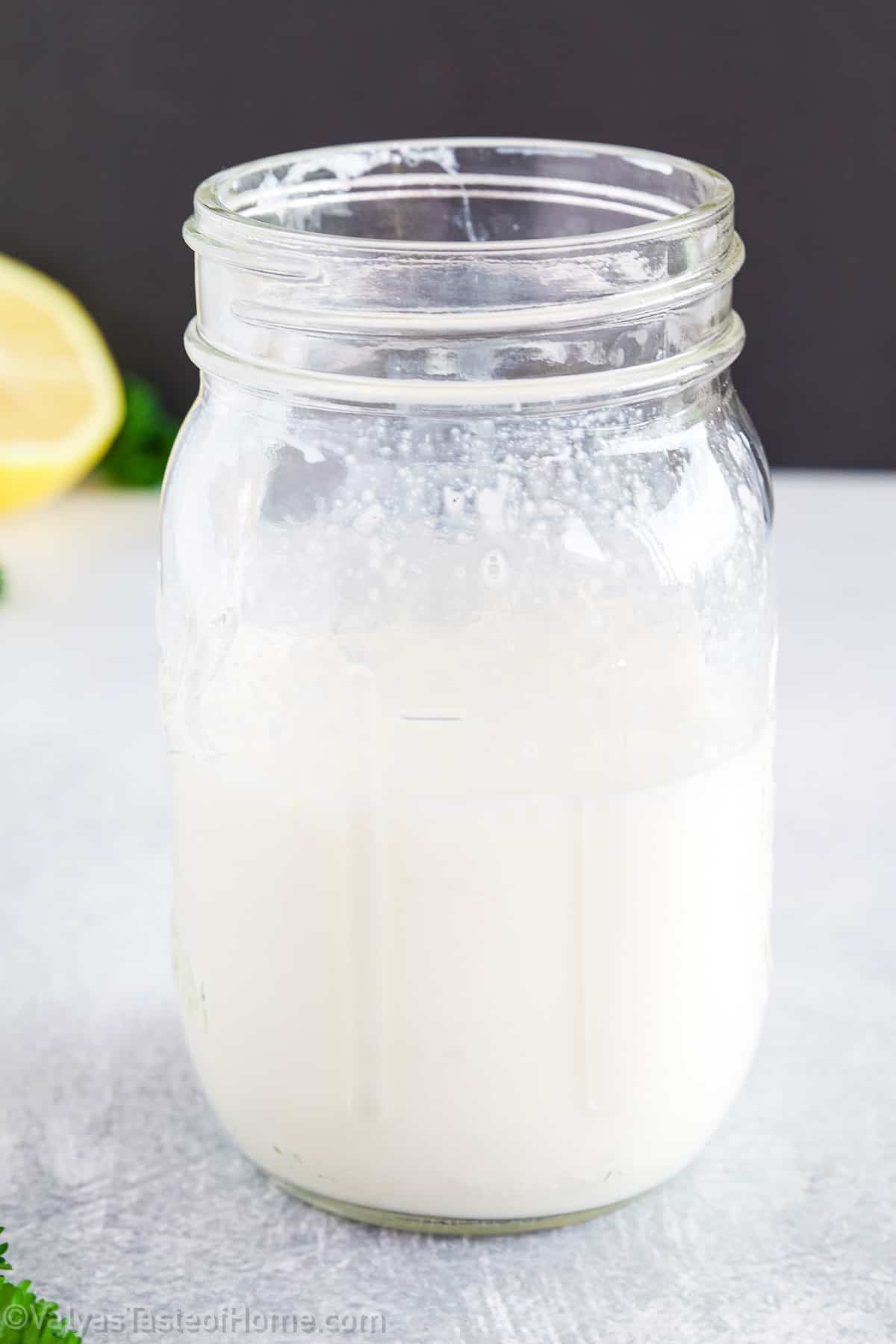
Recipes that Require Buttermilk
- Mini Golden Buttermilk Muffins
- Buttermilk Muffins with Raisins
- The Best Homemade Ranch Dressing Recipe
- Easy Light and Fluffy Vanilla Greek Yogurt Pancakes
Recipe Card
How to Make Buttermilk (Homemade Buttermilk Recipe + Tips)
Ingredients
Ingredients to Make Buttermilk
- 1 cup – grass fed whole milk
- 1 tbsp. – freshly squeezed lemon juice
Instructions
How to Make Buttermilk
- To create your homemade buttermilk, you’ll first need to measure out your whole milk and pour it into a suitable container. Any bowl or jug will work, but ideally, it should be something that allows for easy stirring. Next, take a fresh lemon and squeeze its juice directly into the milk. As a quick tip, rolling the lemon on the counter before you cut it can help to release more juice when you squeeze it.
- Once you’ve added the lemon juice to the milk, use a spoon or a whisk to stir the liquid gently. This is a crucial step as the lemon juice will start to react with the milk, starting the curdling process that will give the buttermilk its tangy flavor and distinctive texture. The stirring ensures that the lemon juice is evenly distributed throughout the milk, thus making sure you get the best results.
- After stirring, leave the mixture to sit on your countertop for around 10 to 15 minutes. During this time, the acid in the lemon juice will continue to react with the bacteria in the milk, further adding to the curdling process. You’ll know your homemade buttermilk is ready when it looks slightly thicker than regular milk and has small curdled milk particles floating on the surface.
- Now your homemade buttermilk is ready to be used! Whether your recipe calls for buttermilk pancakes, buttermilk biscuits, fried chicken, or even a tangy salad dressing, this buttermilk substitute will add that special tangy flavor to all your favorite dishes.
Thank you for following me on Instagram, Facebook, and Pinterest!
The post may contain affiliate links. Read my disclosure.
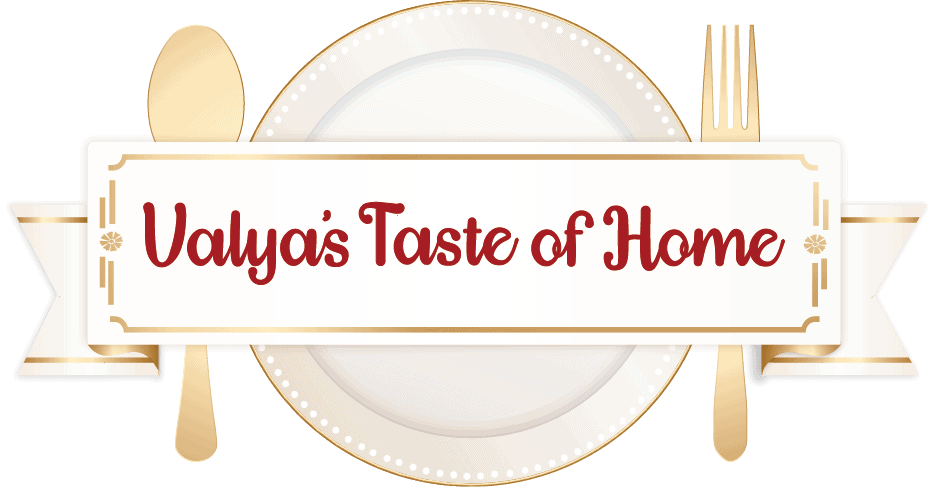




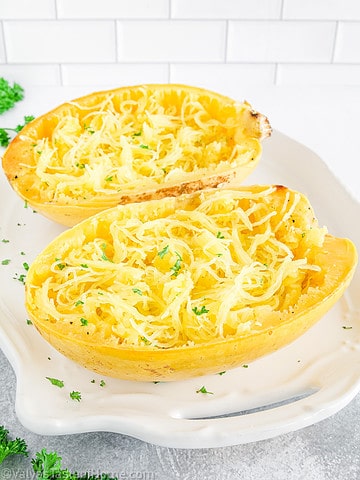


Comments
No Comments